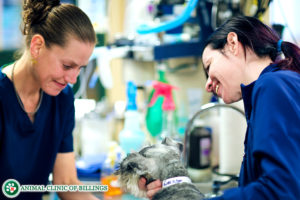Juvenile Pubic Symphysiodesis Dog Surgery
What is Juvenile Pubic Symphysiodesis?
Juvenile Pubic Symphysiodesis is a surgery used to address hip dysplasia in young puppies. It aims to induce a change in the orientation of the hip sockets as the immature pelvis grows in order to increase the surface area that is in contact with the weight-bearing portion of the femoral head. This change in the geometry of the hip joint decreases the abnormal forces that cause stretching, remodeling, and ultimately degneration of the hip joints over time. In this procedure, the growth plate that runs along the midline of the bottom of the pelvis—called the pubic symphysis—is prematurely fused using electrocautery. This prevents further growth in this location. As the rest of the pelvis continues to grow normally, the two sides of the pelvis are forced to rotate slightly downward, causing the hip sockets to assume a slightly more horizontal orientation. It is necessary to spay or neuter all patients undergoing this procedure due to its impact on a female’s ability to give birth as well as the high likelihood of passing on hip dysplasia to offspring.
Who can benefit from a Juvenile Pubic Symphysiodesis?
This procedure will only be effective in young puppies who have yet to undergo signifcant growth of the pelvis. Typically, in puppies under five months old with signs of hip laxity, this surgery is effective in either preventing or significantly reducing the development of hip dysplasia with future growth. However, it is not possible todefinitively determine at such a young age which patients with hip joint laxity will go on to develop significant hip dysplasia without surgery, resulting in the possibility that some patients who have this surgery may not ultimately have needed it.
What is the prognosis with a Juvenile Pubic Symphesiodesis?
When performed at a sufficiently young age, this procedure has a very high likelihood of preventing clinically significant hip dysplasia from developing. In dogs over about five months of age, the odds of success are significantly lower, as too much pelvic growth has already occurred.
What are the potential complications of this surgery?
This surgery is not highly invasive, and has a low rate of complications. Because this procedure does change the shape of the pelvic canal, it can interfere with a female’s future ability to give birth. For this reason, and because hip dysplasia is known to be passed from parents to offspring, all puppies undergoing this surgery should be spayed or neutered.
What does the post-surgical recovery involve?
The post-operative recovery for this surgery is relatively quick and simple compared to other surgeries for hip dysplasia. Following surgery, the patient’s activity must be restricted to short, slow leash walks for two weeks. After this, most patients can return to full activity.

Let our highly trained and experienced team of veterinarians and veterinary technicians help you keep your cat as happy and healthy as they can be.
Call the Animal Clinic of Billings and Animal Surgery Clinic to schedule your pet cat’s next wellness examination with one of our veterinarians today!
406-252-9499 REQUEST AN APPOINTMENT



